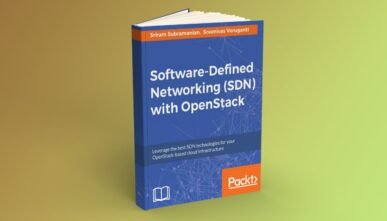Software-Defined Networking(SDN) with OpenStack
About this book
Preface
OpenStack is rapidly becoming the prominent open source platform for building public and private clouds. OpenStack-based clouds are built on three important pillars, namely, compute, storage, and networking. The strength of these pillars determines the robustness, scale, and performance of your OpenStack cloud.
The classic networking landscape is changing, with SDN approach to building networks becoming mainstream, backed by superior economics and the fact that it is a platform for innovation. We believe that the SDN application space will only grow bigger, with innovative applications that are currently in their infancy and it is essentially replacing the conventional network application with the SDN approach.
With both OpenStack and SDN poised for rapid adoption, it is important to understand the key technologies at their intersection. The intent of the book is to provide an overview of the key SDN technologies and their relevance with respect to OpenStack, in a simple and easy to understand format to encourage the reader to dig into the details for deeper insights.
What this book covers
Chapter 1, OpenStack Networking in a Nutshell, provides an overview of OpenStack Networking using Neutron. After introducing core networking constructs such as network, subnet, and port, the chapter will highlight different networking services within OpenStack such as routing, firewall, and VPN.
Chapter 2, Introduction to Software-Defined Networking, introduces the readers to the concepts related to software-defined network. We will look at the challenges in traditional networking, especially in the rapidly evolving cloud infrastructure use case. We introduce different SDN’s concepts by highlighting the advantages of traditional networking.
Chapter 3, SDN Protocols, delves into the underlying components and protocols that enable the SDN-based architecture. We will introduce Open vSwitch (OVS), a popular virtual switch in SDN and OpenStack environments and help you gain insights into SDN building blocks.
Chapter 4, SDN Networking with Open vSwitch, begins with lightweight virtual networking with a Linux network namespace and Open vSwitch functioning as a conventional L2 switch. We will then bring OpenFlow into the mix to depict flow-based networking with virtual machines, interfacing with SDN controller. We will introduce Mininet, a network emulation tool for prototyping network topologies. Finally, we will depict the architecture of Neutron, the networking component of OpenStack.
Chapter 5, Getting Started with OpenDaylight, will help the user get started with OpenDaylight (ODL) as an SDN technology. From an architectural overview of installation and configuration, the goal of this chapter is to give the readers a high-level overview of ODL.
Chapter 6, Using OpenDaylight with OpenStack, will cover ODL-based network service provisioning in OpenStack. Starting with simple multi-tenant virtual networks, the chapter will move on to advanced services such as load balancers and service chaining using ODL. We will also show high-level APIs and the programmability of ODL.
Chapter 7, Getting Started with OpenContrail, helps the user get started with OpenContrail as an SDN technology. From an architectural overview of installation and configuration, the goal of this chapter is to give the audience a high-level overview of OpenContrail.
Chapter 8, OpenContrail Networking with OpenStack, explains OpenStack and OpenContrail integration. Starting with simple multi-tenant overlay networks, the chapter will move on to advanced services, such as security and service chaining using OpenContrail.
Chapter 9, Open Network Operating System (ONOS), starts with an introduction to ONOS its architecture, and then explores ONOS integration with Open vSwitch (OVS). We will conclude the chapter with a quick introduction to using ONOS in an OpenStack environment.
Chapter 10, OVN and Open vSwitch Enhancements, outlines the limitations in the classic Neutron architecture and covers solutions such as OVN, Distributed Virtual Router (DVR), Dragonflow, and Open vSwitch Data Path Development Kit (OVS-DPDK). The chapter covers how OVN integrates with OpenStack and the mapping of their object model.



